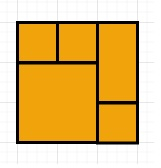
 Data Structure
Data Structure Networking
Networking RDBMS
RDBMS Operating System
Operating System Java
Java MS Excel
MS Excel iOS
iOS HTML
HTML CSS
CSS Android
Android Python
Python C Programming
C Programming C++
C++ C#
C# MongoDB
MongoDB MySQL
MySQL Javascript
Javascript PHP
PHPPhysics
Chemistry
Biology
Mathematics
English
Economics
Psychology
Social Studies
Fashion Studies
Legal Studies
- Selected Reading
- UPSC IAS Exams Notes
- Developer's Best Practices
- Questions and Answers
- Effective Resume Writing
- HR Interview Questions
- Computer Glossary
- Who is Who
Perfect Rectangle in C++
Suppose we have N axis-aligned rectangles, we have to check whether they all together form an exact cover of a rectangular region or not. Here each rectangle is represented as a bottom-left point and a top-right point. So a unit square is represented as [1,1,2,2]. (bottom-left point is (1, 1) and top-right point is (2, 2)).
So, if the input is like rectangles = [[1,1,3,3],[3,1,4,2],[3,2,4,4],[1,3,2,4],[2,3,3,4]], then the output will be true as all 5 rectangles together form an exact cover of a rectangular region.

To solve this, we will follow these steps −
Define one set visited
area := 0
x2 := -inf, x1 := inf
y2 := -inf, y1 := inf
for each r in given list re −
x1 := minimum of r[0] and x1
x2 := maximum of r[2] and x2
y1 := minimum of r[1] and y1
y2 := maximum of r[3] and y2
area := area + ((r[2] - r[0]) * (r[3] - r[1]))
s1 := r[0] concatenate r[1]
s2 := r[0] concatenate r[3]
s3 := r[2] concatenate r[3]
s4 := r[2] concatenate r[1]
if s1 is visited, then −
delete s1 from visited
Otherwise
insert s1 into visited
if s2 is visited, then −
delete s2 from visited
Otherwise
insert s2 into visited
if s3 is visited, then −
delete s3 from visited
Otherwise
insert s3 into visited
if s4 is visited, then −
delete s4 from visited
Otherwise
insert s4 into visited
s1 := concatenate x1 and y1
s2 := concatenate x2 and y1
s3 := concatenate x1 and y2
s4 := concatenate x2 and y2
if s1, s2, s3, s4 all are not visited, then
return false
return true when area is same as ((x2 - x1) * (y2 - y1))
Example
Let us see the following implementation to get better understanding −
#include <bits/stdc++.h>
using namespace std;
class Solution {
public:
bool isRectangleCover(vector<vector<int>> &re) {
unordered_set<string> visited;
int area = 0;
int x2 = INT_MIN;
int x1 = INT_MAX;
int y2 = INT_MIN;
int y1 = INT_MAX;
for (auto &r : re) {
x1 = min(r[0], x1);
x2 = max(r[2], x2);
y1 = min(r[1], y1);
y2 = max(r[3], y2);
area += (r[2] - r[0]) * (r[3] - r[1]);
string s1 = to_string(r[0]) + to_string(r[1]);
string s2 = to_string(r[0]) + to_string(r[3]);
string s3 = to_string(r[2]) + to_string(r[3]);
string s4 = to_string(r[2]) + to_string(r[1]);
if (visited.count(s1)) {
visited.erase(s1);
}
else
visited.insert(s1);
if (visited.count(s2)) {
visited.erase(s2);
}
else
visited.insert(s2);
if (visited.count(s3)) {
visited.erase(s3);
}
else
visited.insert(s3);
if (visited.count(s4)) {
visited.erase(s4);
}
else
visited.insert(s4);
}
string s1 = to_string(x1) + to_string(y1);
string s2 = to_string(x2) + to_string(y1);
string s3 = to_string(x1) + to_string(y2);
string s4 = to_string(x2) + to_string(y2);
if (!visited.count(s1) || !visited.count(s2) || !visited.count(s3) || !visited.count(s4) || visited.size() != 4)
return false;
return area == (x2 - x1) * (y2 - y1);
}
};
main() {
Solution ob;
vector<vector<int>> v = {{1, 1, 3, 3}, {3, 1, 4, 2}, {3, 2, 4, 4}, {1, 3, 2, 4}, {2, 3, 3, 4}};
cout << (ob.isRectangleCover(v));
}Input
{{1, 1, 3, 3}, {3, 1, 4, 2}, {3, 2, 4, 4}, {1, 3, 2, 4}, {2, 3, 3, 4}}Output
1

